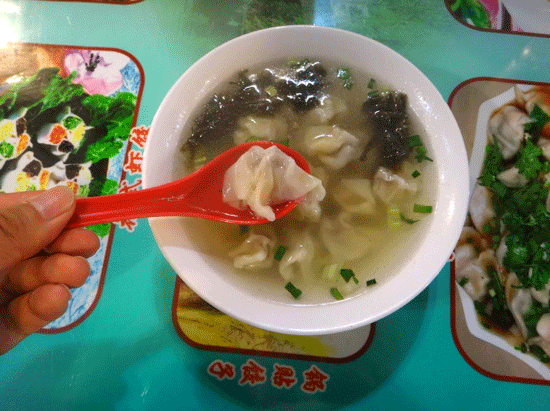Wonton Longings
Updated: 2011-10-16 07:58
By Zhou Wenting (China Daily)
|
|||||||||

|
The delicate little dumplings, xiaohuntun, floating in clear broth are beloved in Shanghai, Zhejiang and Jiangsu provinces. [Gao Erqiang / China Daily] |
Shanghai
People in Shanghai love the little cloud-like dumplings in soup that they call xiaohuntun. Zhou Wenting shares the story of her addiction to this hometown delight.
As a Shanghai native working in Beijing, I insist on having my little wontons for breakfast every time I go home. My father will call me on the phone the day before I return, assuring me he's already bought them and that they are waiting for me.
Xiaohuntun or the little wontons are a specialty in Shanghai and the neighboring Zhejiang and Jiangsu province. Instead of being just a smaller wonton, this is totally different in appearance and taste and only shares part of the name.
You have to temper your enthusiasm when eating them, because the delicate little dumplings in their paper-thin wrappers can slip down your throat too easily.
In Shanghai, people go to breakfast stands near food markets or fast food chains for their morning hit of little wontons. Often, the mistress of the house will make it for the family.
My mother makes very good little wontons and I like watching her wrap the dumplings, which seems so effortless.
The technique of crumpling the wrappers around the tiny nubs of filling seems very casual, but it needs experience to do it properly.
After making the filling with pork and seasoning, my mother will lay a square wrapper on her left palm, and deftly use her right hand to put a marble-sized ball of filling on the wrapper.
Next, she gathers the wrapper together with her fingers, just as if she was crumpling a piece of paper.
That is the pivotal step because the wrapper must enclose the filling so it does not disintegrate during cooking, but still float around the filling like a soft cloud. The soup is also delicate.
"Usually we add tiny dried shrimps, thinly-sliced omelet, nori and mustard tuber to make it more appealing to both eyes and tongues," says Qiao Xiaomei, 63, from Shanghai.
To most, the little wonton is more than just a snack. But to some, it is a reminder of home and younger days.
Many middle-aged people we interviewed all agreed that the dish was a lot simpler in their childhood.
"We use to put only lard and spring onions in the soup, because life was not that affluent," says Wang Qi, 52. She lived downtown in Shanghai when she was young and she remembered her family gathering to eat little wontons.
"Sometimes my mother cooked little wontons after coming back home from work as a snack for us before dinner, in case we were hungry. My three brothers and I would all wait in the kitchen.
"After she added sesame oil to the soup and carried it to the table, we swarmed around and shared that big bowl of little wontons."
For a treat, families would go out to eat, although at a time when food coupons were rationed, these treats were few and far between.
Wangjiasha is a well-known restaurant chain in Shanghai, and Wang Qi remembers that a bowl of little wontons cost 12 cents ($0.02) in the 1960s. Now, it can cost anything from 5 yuan to more than 10 yuan.
You can contact the writer atzhouwenting@chinadaily.com.cn.










